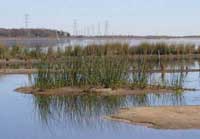|
Restoration in Port Arthur, Texas
 |
Pilot restoration project in 2004
showing a "pimple mound."
|
Increasing benefits through combined Remediation and Restoration
The Old Gulf Refinery site in Port Arthur, Texas, has been an active refinery since the 1902 discovery of oil in the area known as "Spindletop." Activities at the site led to releases of hazardous chemicals that threatened human health and the environment, mainly within portions of the Neches River system. The National Oceanic and Atmospheric Administration (NOAA) and the Texas trustees worked with Texas Commission on Environmental Quality to achieve remedial goals at the site that addressed these releases of hazardous substances, including aromatic hydrocarbons and toxic metals. Work was initiated in 1993 to control potential sources of contamination and to ensure that human and environmental health would be protected from further risk. Simultaneously, the trustees worked with the potentially responsible parties (PRPs) to negotiate a cooperative Natural Resource Damage Assessment (NRDA) for the site that would address past injuries to natural resources.
NOAA and the Texas Natural Resource Trustees (Texas Commission on Environmental Quality, Texas Parks and Wildlife, Texas General Land Office, and U.S. Fish and Wildlife Service) finalized the integrated Environmental Assessment/Restoration Plan for the site in 2004. At the same time, the trustees also reached a cooperative settlement with the PRPs to resolve natural resource damage liability at the site. The cooperative agreement between the PRPs and trustees avoided costly and time-consuming litigation, and provided the opportunity for expeditious restoration of natural resources. According to the agreement, the PRPs chose to undertake themselves the restoration projects which would compensate for past injuries.
The selected restoration projects will result in the creation of 83 acres of intertidal wetland and 30 acres of coastal wet prairie, plus water control structures to improve 1600 acres of habitat in the Neches River basin. These wetland enhancements will improve conditions for numerous aquatic and semi-aquatic plants, and for the fish and wildlife that use these wetland habitats.
The PRPs completed a pilot restoration project in early 2004 with great success. Permits for full project construction were issued in 2005. As of fall 2006, construction, which had been delayed due to hurricanes, had begun. The marsh and wet prairie projects will be built simultaneously. Soil will be removed from currently dry land, lowering the soil level to wet prairie elevation. Slurries of that soil and ambient water (at a controlled consistency) will be pumped to the currently open water areas to create hundreds of "pimple mounds." With an eye on reduced material handling costs and increased constructability, the trustees and the PRPs designed this restoration project, in consultation with NOAA Fisheries, as a cost-efficient way to resolve NRDA
In this area of Texas, there are several hazardous waste sites and large areas of subsided wetlands where similar projects could be constructed, creating an ideal opportunity for combined remediation and restoration. Such projects carry maximum benefit by providing significant improvements to natural resources at a reduced expenditure of time and money.
For more information on this project:
|
|
|
|
|
|
|
|


